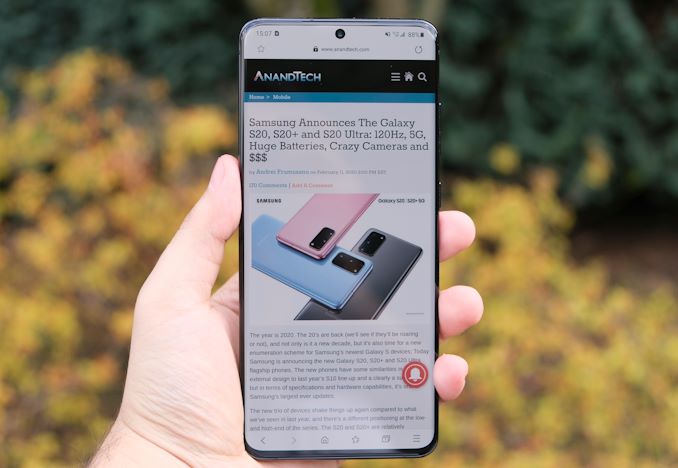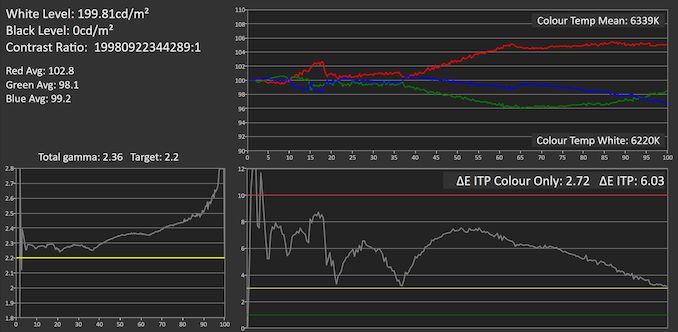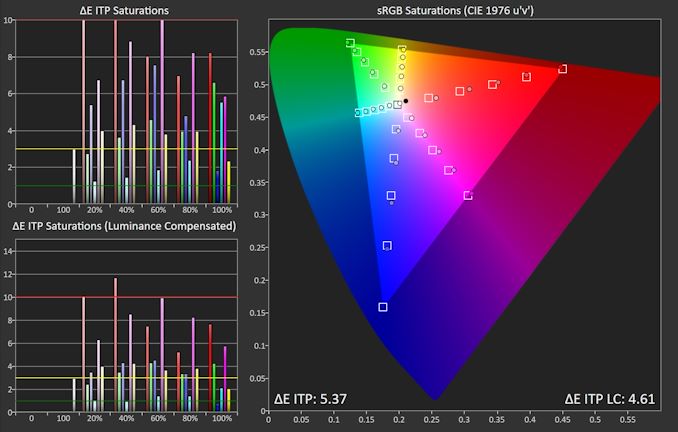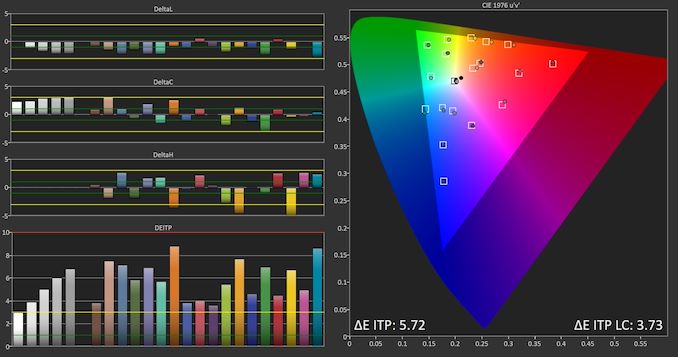The Samsung Galaxy S20+, S20 Ultra Exynos & Snapdragon Review: Megalomania Devices
by Andrei Frumusanu on April 3, 2020 9:30 AM ESTDisplay Measurement
The Galaxy S20’s screens follow the same recipe that we found on the S10 and Note10 series, and other than the 120Hz display modes, the new panels don’t have any major new changes to them when it comes to features or display quality changes.
We move on to the display calibration and fundamental display measurements of the Galaxy S20 screen. As always, we thank X-Rite and SpecraCal, as our measurements are performed with an X-Rite i1Pro 2 spectrophotometer, with the exception of black levels which are measured with an i1Display Pro colorimeter. Data is collected and examined using Portrait Display's CalMAN software.

In terms of brightness, the S20 Ultra and S20+ fall in line with what we’ve seen from Samsung phones over the past few generations. The panel goes up to 325 nits in maximum manual brightness mode, and boosts up to 731 nits at full screen white when under auto brightness and high ambient light. The lower the APL of your content, the brighter the screen will become.
The S20 series is identical to the S10 series when it comes to the display settings; we find the phone comes by default in a “Vivid” mode with a larger color gamut target for all content. But what’s new here is that this generation Samsung has included a color temperature slider offering not only a few discrete choices between cool and warm, but it also gives the option for fine-tuning the RGB balance as well. Nevertheless, the accurate color profile for the phone is the “Natural” one which aims for sRGB colors for default contents and is able to support wider color targets for color managed applications.
Unfortunately, the S20 doesn’t really behave any different to the S10 series, and we find the same characteristics in the calibration between the phones. The worst offender here is the color temperature which is far too warm at an average of 6330K across all grey levels, and a white falling in at 6220K. Samsung keeps doing this year after year and at this point I just don’t know what the point is anymore in hoping that they would finally get it right.
The resulting gamma is also quite off and will wildly vary in the measurement depending on your pattern’s APL. We’ve had tons of phones fail at this aspect as the panels are calibrated without consideration of the CABC mechanisms of the display – for some vendors it’s even possible to retrace the methodologies and showcase where they went wrong in the calibration.
At this point I should note that we’ve slightly revamped our display reporting methodology, and have now moved from showcasing dE2000 error values to the newer dEITP standard, which is more strict in its error figure handling.
The S20 Ultra here ends up with a dEITP of 6.03 because of the color and luminosity errors, and just the color error would lend it a dEITP of 2.72. I’ll be remeasuring more devices and bring back comparison charts on other devices with the new dE standard in upcoming reviews.
Saturation targets for the S20 are also in line with what we’re used to from Galaxy phones – not great, but not totally bad either. The major issue again is the shift of the spectrum towards reds.
The Gretag MacBeth chart with common human color tones is also just somewhat acceptable, with the commonality of gamma errors, but also some larger hue errors due to the shift towards reds.
A Typical Galaxy Display
Overall, the S20 series come with what I’d call typical Galaxy displays. The panel is fantastic quality, and there’s nothing to criticize it in terms of its intrinsic qualities. The calibration is a bit more lackluster and in-line with what we’ve become accustomed from Samsung, key points being that the gamma is off yet again, and the Natural display mode is also too warm, yet again. It’s not a deal breaker, but Samsung has done better in the past. In any case, they remain high quality displays which are just short of being outstanding.
















137 Comments
View All Comments
airdrifting - Monday, April 6, 2020 - link
I am actually a very forgiving person, I gave them 4 chances but they botched all. And then there was the Samsung Note catching fire left and right while Samsung PR was lying to cover up, that was the last straw for me. I was very skeptical when I switched to Oneplus, but I was very impressed with the build quality and speedy updates, the only weak point was the camera.tuxRoller - Sunday, April 5, 2020 - link
Any thoughts as to why Huawei was having issues with the A77?BedfordTim - Sunday, April 5, 2020 - link
They say the battery life penalty means the extra performance isn't worth it. This fits with their energy use figures in the benchmarks which are very good. It also makes sense from a user perspective as the extra performance will not be noticeable in everyday use.iphonebestgamephone - Monday, April 6, 2020 - link
How come qualcomm improved efficiency then? Its more like hisilicon had no time.Andrei Frumusanu - Monday, April 6, 2020 - link
I don't think they had issue, they probably didn't have time.tuxRoller - Tuesday, April 7, 2020 - link
You're probably right.Any idea as to why they were running late this time? The arm update cadence has been reliably in May since at least the A72.
** A - R ** - Sunday, April 5, 2020 - link
Andrei,For storage benchmarks, how about this (cpdt) app ?
https://play.google.com/store/apps/details?id=com....
Andrei Frumusanu - Monday, April 6, 2020 - link
It's not useful - there's very different aspects of storage performance on Android that's not covered by these traditional tests.Arian_amg - Sunday, April 5, 2020 - link
Thanks for great reviews:)I waited for this one like hell... With these Corona situations it's hard to find entertaining content and as always you nailed it best chipset reviews I've ever seen most will getaway with some benchmark and thats it
Im really looking forward for the dimensity 1000 and kirin 820 to get a proper understanding of new Valhalla cores with a proper node
(btw do you agree with huawei that they said they didn't use a77 because it didn't reach a certain clock(I know it had much higher ipc than a76)?)
Andrei Frumusanu - Monday, April 6, 2020 - link
HiSilicon probably had less time to integrate the A77 and thus didn't reach good clocks.